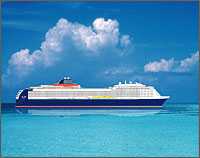Project America
 Artist rendering of The Project America | |
| Class overview | |
|---|---|
| Builders: | Litton Ingalls, Lloyd Werft |
| Operators: |
United States Lines Norwegian Cruise Line (for modifications and completion) |
| Built: | 1999-2005 |
| In service: |
Never completed for United States Lines NCL (2005–) |
| Planned: | 2 |
| Completed: | 1 (modified) |
| Cancelled: | 1 |
| Active: | 1 |
| General characteristics (as designed) | |
| Tonnage: | 72,000 GT |
| Length: | 840 ft (260 m) |
| Capacity: | 1,900 Passengers |
| General characteristics (built as Pride of America) | |
| Tonnage: | 81,000 GT |
| Length: | 920.6 ft (280.6 m) |
| Beam: | 105.6 ft (32.2 m) |
| Draught: | 26 ft (7.9 m) |
| Decks: | 15 |
| Capacity: | 2,146 passengers |
| Crew: | 900 |
Project America was the designation for a contract between American Classic Voyages (AMCV) and the Litton Ingalls Shipyard of Pascagoula, Mississippi. The contract was to build two cruise ships, with a gross tonnage of 72,000 each, with an option for a third vessel. The contract had the initial potential value of $1.4 billion U.S. dollars.
History
The intention of the project, aside from perceived financial viability, was to revitalize the U.S. passenger cruise shipbuilding industry. These ships were to be the largest cruise ships ever built in the U.S., with the first planned to enter service in early 2003. As points of nostalgia and history, Ingalls delivered the last American-built large cruise ships, Brasil and Argentina, in 1958.[1]
Construction began in June, 2000 but the bankruptcy of AMCV in October, 2001 halted the project and left only the partially completed hull of the first ship, and parts and supplies for the second, to sit idle at the Ingalls shipyard. If Ingalls had been able to complete one ship, it would have represented the first U.S. cruise ship construction in more than 40 years.
NCL's Involvement

In late 2002, Norwegian Cruise Line (NCL) contracted with Northrop Grumman Ship Systems, the owner of Ingalls, to buy all of the materials, equipment and work performed on the two Project America vessels. All materials were towed to Germany and the first ship was completed at Lloyd Werft Shipyard in Bremerhaven. The ship was modified to increase its size, now 81,000 GT, and exterior and interior changes were made. This ship was named the Pride of America and entered service in 2005.
The materials for the second Project America ship were utilized in the construction of the Pride of Hawaii (now named Norwegian Jade), at Meyer Werft Shipyard in Papenburg. Pride of Hawaii entered service in 2006 and is approximately 12,000 GT larger than Pride of America. It is considered a Jewel Class ship, which is a different class entirely than that of the Pride of America.
Passenger Vessel Services Act
In exchange for its purchase of the Project America materials, NCL lobbied heavily for an exception to the Passenger Vessel Services Act, which prohibits foreign built ships from operating between U.S. ports without making a foreign stop in between. The exception was granted and three ships (the afore mentioned as well as Pride of Aloha), effectively all foreign built, were allowed to fly the U.S. flag. This exception allows NCL to have an exclusive right to operate Hawaiian itineraries that do not need to touch a foreign port. A caveat of this exception, however, requires NCL to staff these ships with a crew made up of predominantly U.S. citizens.
Goals
Project America was the result of the U.S.-Flag Cruise Ship Pilot Project Statute passed by Congress in 1997, designed to do the following:
- Revitalize the U.S.-flag oceangoing cruise ship fleet
- Create more than 5,000 American jobs
- Help sustain and modernize the U.S. shipbuilding industrial base
- Increase U.S. tax revenues
- Boost Hawaii tourism
- Expand consumers' leisure travel opportunities
Support
The Department of Defense and the U.S. Maritime Administration (MARAD) strongly supported the U.S.-Flag Ship Pilot Project. The project enjoyed great political support from Mississippi’s U.S. Senators, Thad Cochran and Trent Lott, as well as U.S. Senator Daniel Inouye of Hawaii.
Original Ship Plans
The ships were planned to cruise within the Hawaiian Islands and were to represent the state-of-the-art in comfort and luxury. At an estimated 840 feet (260 m) long, each ship was to be approximately 72,000 GT. Each vessel was to feature a four-deck-high atrium, a 1,060-seat dining room, an 840-seat theater, a 590-seat cabaret lounge, and a "uniquely Hawaiian" outdoor performance stage.
Plans called for accommodations for 1,900 passengers which included 950 cabins, 77 percent of which were to be "outside cabins," and 64 percent of which were to have private balconies. The ships were to have 85,850 square feet (7,976 m2) of open deck space, extensive health spa and gymnasium facilities, and 2,100 square feet (200 m2) of conference space. In addition, the upper three decks of the ships were to be designed to "maximize the sense of spaciousness on board, and provide passengers with panoramic views of the Hawaiian Islands and the surrounding Pacific Ocean".[2]
External links
References
- ↑ "The Moore-McCormack Lines". Retrieved 2007-10-06.
- ↑ "AMERICAN CLASSIC VOYAGES CO. (AMCV) SIGNS MAJOR CONTRACT WITH INGALLS FOR LUXURY CRUISE SHIP CONSTRUCTION". Archived from the original on 2007-08-14. Retrieved 2007-10-06.